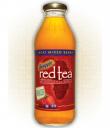 As a rabid tea sucker, I’ve been very intrigued by Snapple’s ad scheme for their new Green, Red, and White teas. America, by and large, is not a tea drinking country. In the places it is it tends to be in the form of a sweet tea, or some other generic iced variety (though I’m sure hardcore Southern sweet tea aficionados would cringe at my use of the word “generic”). That being said, America, I think, still views tea much as it did coffee until a decade or so ago. “Coffee” and “Tea” were just that, singular, generic products. There was no “caramel macchittos” and the mention of the word “cappucino” would conjure up images of uptight, WASPy, upper-crusters.
As a rabid tea sucker, I’ve been very intrigued by Snapple’s ad scheme for their new Green, Red, and White teas. America, by and large, is not a tea drinking country. In the places it is it tends to be in the form of a sweet tea, or some other generic iced variety (though I’m sure hardcore Southern sweet tea aficionados would cringe at my use of the word “generic”). That being said, America, I think, still views tea much as it did coffee until a decade or so ago. “Coffee” and “Tea” were just that, singular, generic products. There was no “caramel macchittos” and the mention of the word “cappucino” would conjure up images of uptight, WASPy, upper-crusters.
“Whaddya mean, ‘what kind of coffee?’ I want coffee coffee, what other kind is there?” is the common refrain from stodgy old-schoolers. As an aside, I’ve often found this anti-choice attitude baffling in a country that prides itself on its range of consumer choice options.
Starbucks and other such places changed that and Starbucks is now so ubiquitous that every white-collar paper-pusher and soccer mom has their own favorite Frap flavor.
Unfortunately, tea’s popularity did not follow suit, and until lately has been relegated to the either the frumpy grandma or the “hippie” stereotype. That’s why it’s encouraging to see Snapple take a different approach to selling tea. The new ads that Snapple has out take a kind of educational route. Thus, where there may not be a vibrant market, they have decided to nurture and create one.
Snapple’s Website has a fun tea FAQ for each of the White, Green, and Red teas, and you can watch the ads there as well. Personally, my favorite is the latest one for their Rooibos Red Tea (they even used the real name, good for them). The great thing about the commercials is that they manage to be informative without sounding pretentious. They mainly emphasize the health aspects of tea, but the white and red tea commercials also introduce people to just what exactly these two kinds of tea ARE as well. Many companies would have tried to take the route of branding it as an exotic, or premium product. Snapple, in a way, takes the exact opposite approach, and explains that, yes, it may sound exotic at first, but that’s not the point. The point is it tastes good and it’s good for you.
I’m no advertising genius, and until halfway through my undergraduate Anthropology studies I pretty much agreed with Bill Hicks that anyone involved in the advertising world was the scum of the Earth. However! if Snapple can make tea a more prevalent beverage in America, then I will eat my words, shoes, and possibly my pants too. I’d love to see something like an Argo Tea in my city. Anything that makes that happen has my respect.